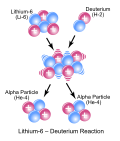Search results
Showing results for nuclide. No results found for Nuclino.
The page "Nuclino" does not exist. You can create a draft and submit it for review or request that a redirect be created, but consider checking the search results below to see whether the topic is already covered.
- Nuclide notation)Isotopes are distinct nuclear species (or nuclides) of the same chemical element. They have the same atomic number (number of protons in their nuclei)...47 KB (5,822 words) - 02:04, 9 April 2024
- A table or chart of nuclides is a two-dimensional graph of isotopes of the elements, in which one axis represents the number of neutrons (symbol N) and...13 KB (1,346 words) - 21:19, 17 January 2024
 Isobars are atoms (nuclides) of different chemical elements that have the same number of nucleons. Correspondingly, isobars differ in atomic number (or...6 KB (768 words) - 14:30, 22 November 2023
Isobars are atoms (nuclides) of different chemical elements that have the same number of nucleons. Correspondingly, isobars differ in atomic number (or...6 KB (768 words) - 14:30, 22 November 2023- Fissionable nuclide)= number of protons). The term fissile is distinct from fissionable. A nuclide capable of undergoing fission (even with a low probability) after capturing...12 KB (1,749 words) - 03:34, 17 November 2023
- Radio-nuclide)A radionuclide (radioactive nuclide, radioisotope or radioactive isotope) is a nuclide that has excess numbers of either neutrons or protons, giving it...31 KB (2,651 words) - 23:54, 22 April 2024
- Cosmogenic nuclides (or cosmogenic isotopes) are rare nuclides (isotopes) created when a high-energy cosmic ray interacts with the nucleus of an in situ...13 KB (1,268 words) - 19:05, 10 April 2024
- Parent nuclide)daughter product, daughter isotope, radio-daughter, or daughter nuclide) is the remaining nuclide left over from radioactive decay. Radioactive decay often...4 KB (428 words) - 23:29, 18 October 2022
- This list of nuclides shows observed nuclides that either are stable or, if radioactive, have half-lives longer than one hour. This represents isotopes...164 KB (3,035 words) - 04:43, 22 April 2024
 and nuclide of a chemical element is, therefore, a number that can in principle be measured to high precision, since every specimen of such a nuclide is...21 KB (2,713 words) - 09:10, 5 April 2024
and nuclide of a chemical element is, therefore, a number that can in principle be measured to high precision, since every specimen of such a nuclide is...21 KB (2,713 words) - 09:10, 5 April 2024 Island of stability (section Nuclide stability)these elements. It is predicted to appear as an "island" in the chart of nuclides, separated from known stable and long-lived primordial radionuclides. Its...90 KB (8,795 words) - 03:23, 23 March 2024
Island of stability (section Nuclide stability)these elements. It is predicted to appear as an "island" in the chart of nuclides, separated from known stable and long-lived primordial radionuclides. Its...90 KB (8,795 words) - 03:23, 23 March 2024- Isomeric nuclide)a nuclear isomer can even exceed that of the ground state of the same nuclide, as shown by 180m 73Ta as well as 192m2 77Ir , 210m 83Bi , 242m 95Am and...29 KB (3,478 words) - 03:29, 4 March 2024
)







